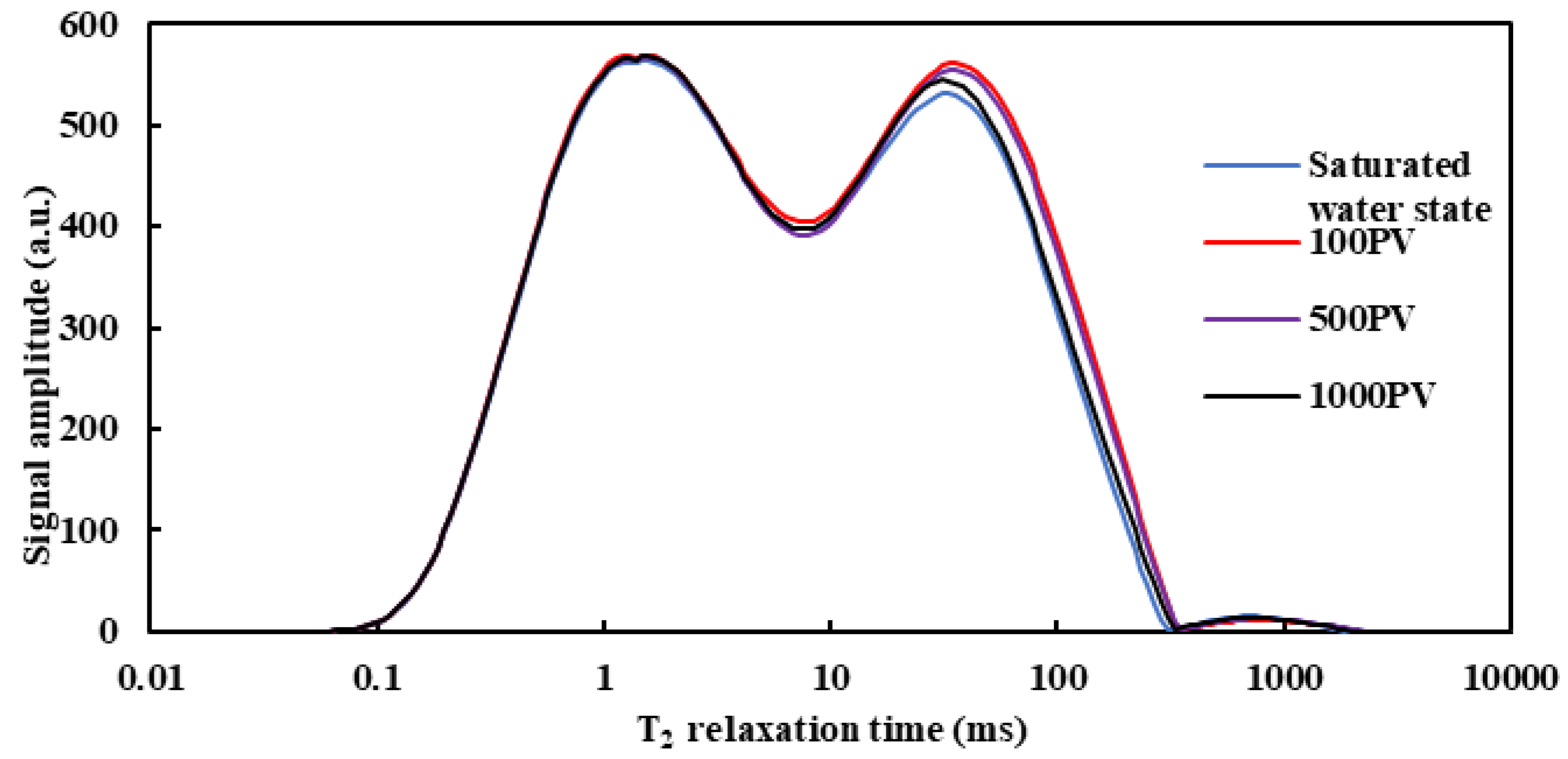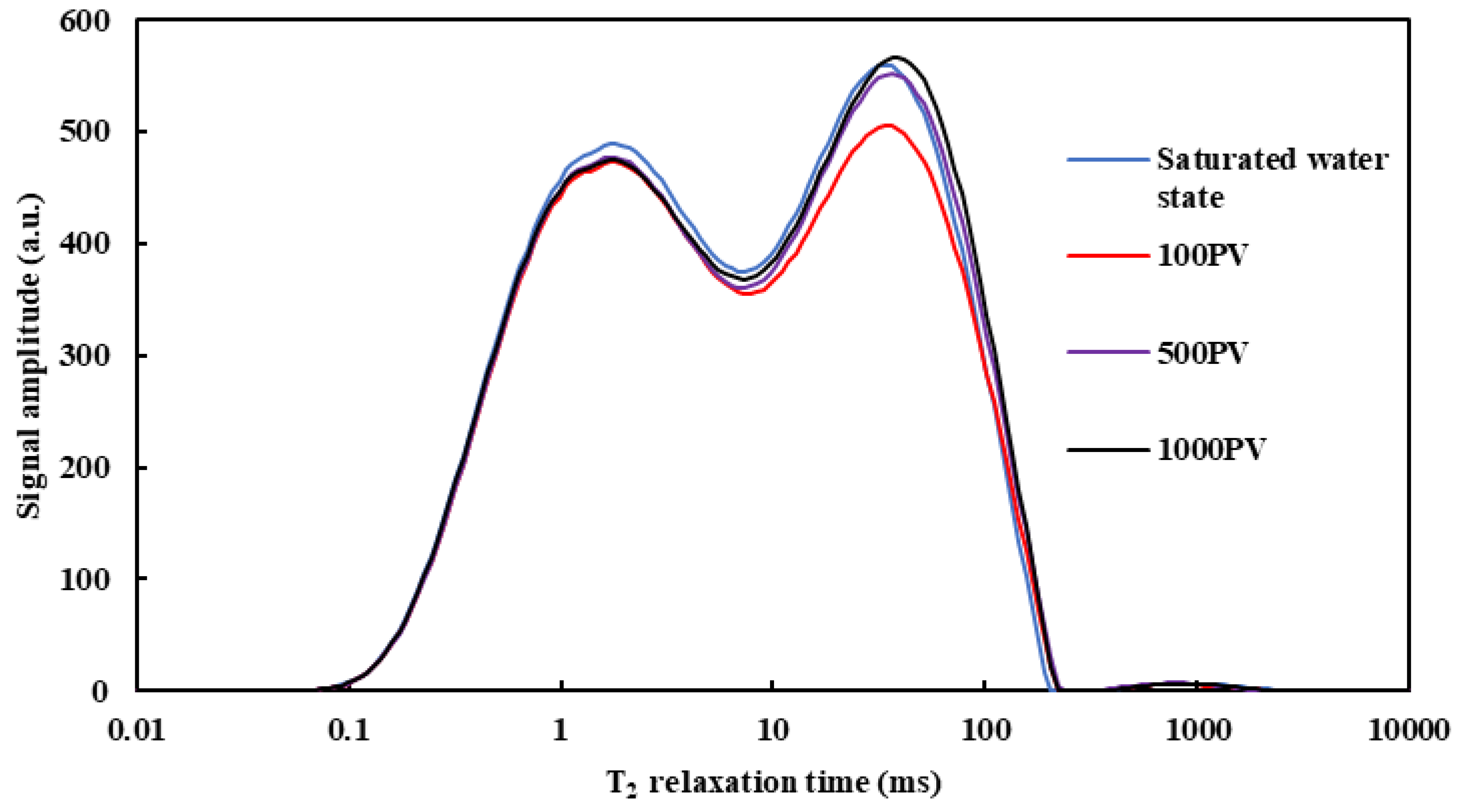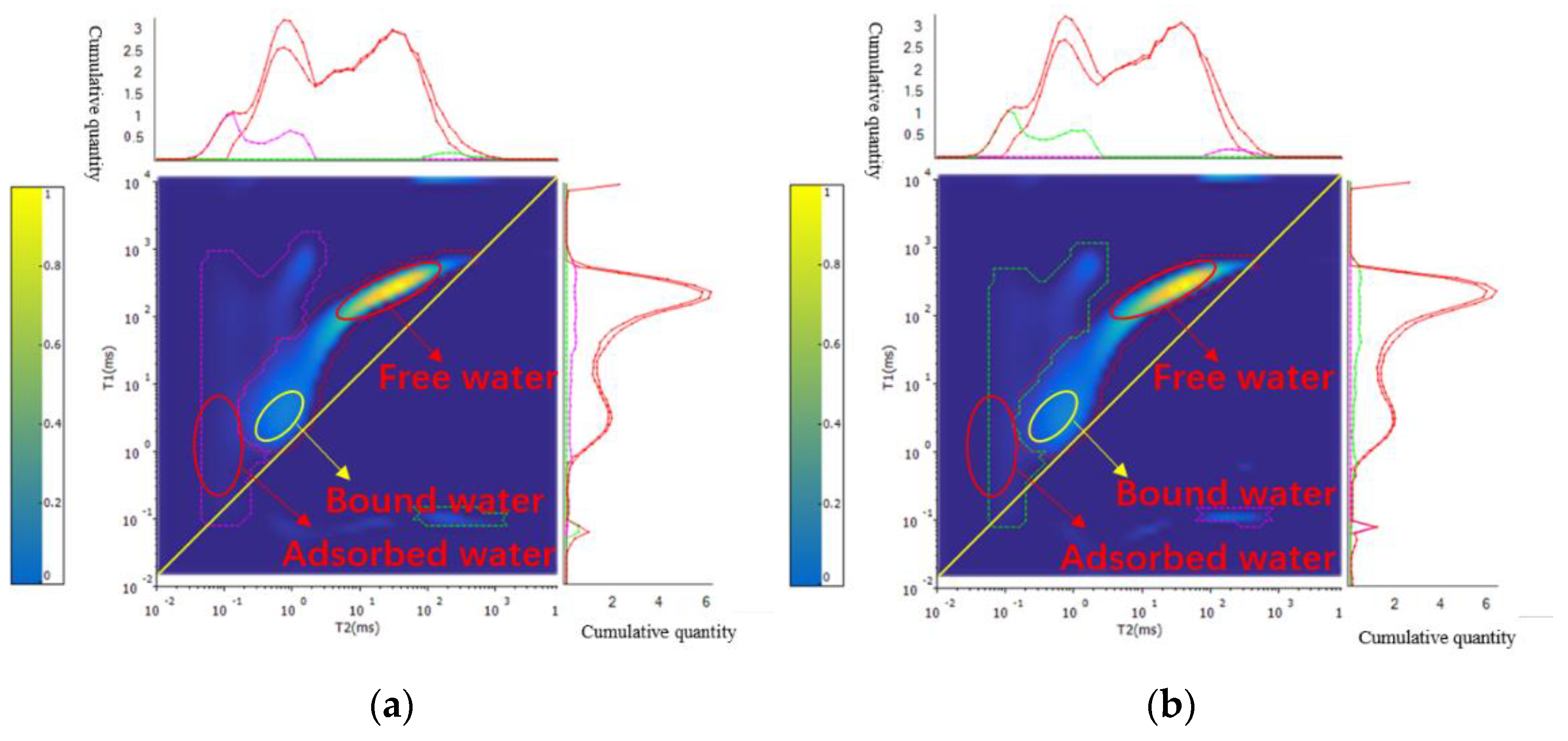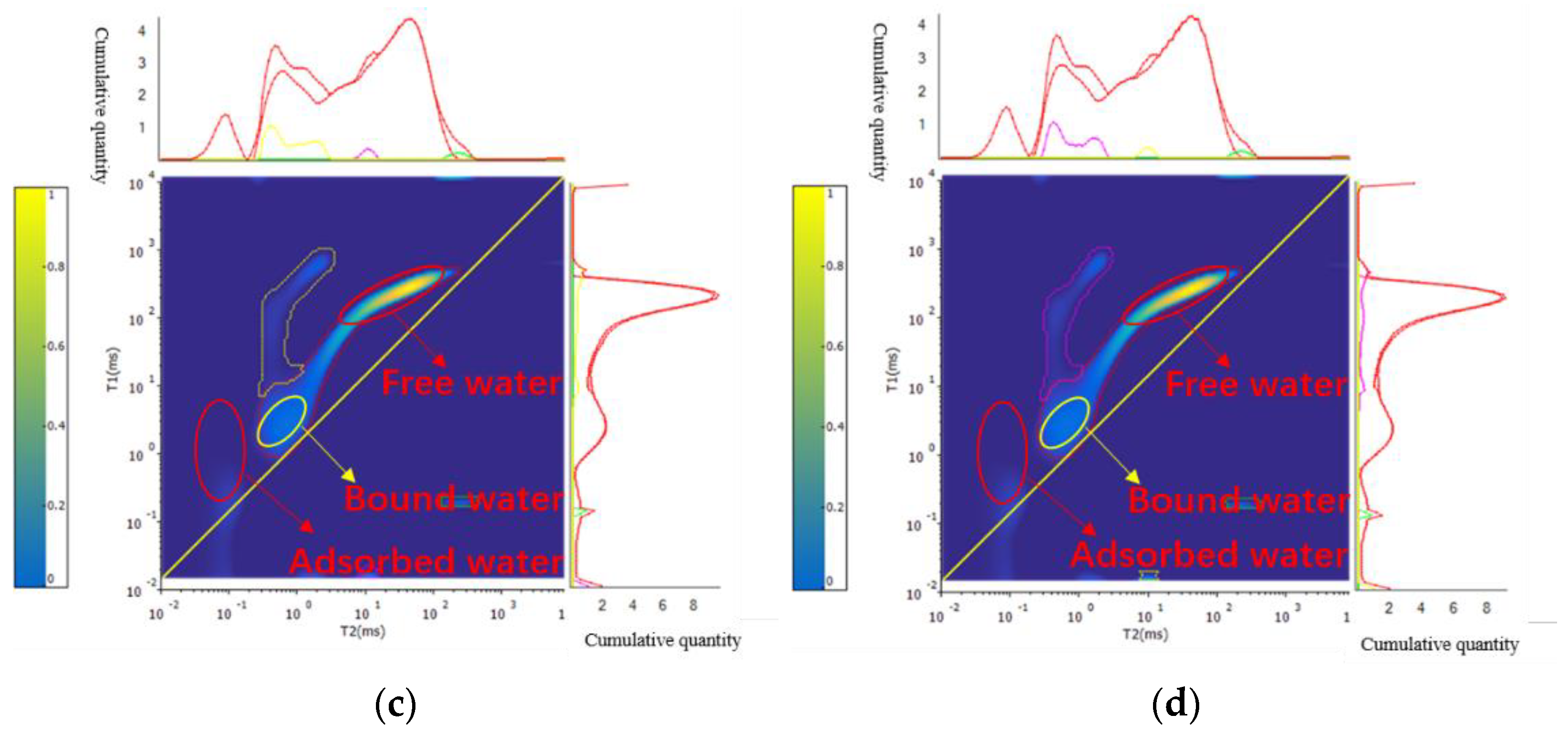Study on the Variation Law of Reservoir Physical Properties in High Water Cut Stage
Abstract
:1. Introduction
2. Core Attribute Parameters
3. Experiment
3.1. Experimental Equipment
3.2. Classification of Fluid Types by Two-Dimensional Nuclear Magnetic Spectroscopy
3.3. Design of High-Expansion Water Injection Scheme
- (1)
- Take target cores 8-2, 16-1, and core 9 for oil washing and drying.
- (2)
- Measure the target rock core’s length, diameter, porosity, and permeability.
- (3)
- Place the core in formation water with a mineralization of 5000 mg/L, with the formation water surface covering the top of the core, and vacuumize for 48 h a vacuum pump to fully saturate the experimental core with formation water (saturation water stage).
- (4)
- Place the core in a displacement device, inject water at a fixed flow rate of 1.0 mL/min, and record the water output and pressure.
- (5)
- Collect two-dimensional nuclear magnetic resonance when the cumulative water injection reaches 100 PV, 500 PV, and 1000 PV. The experiment ends when the accumulated water injection reaches 1000 PV.
- (6)
- Calculate the permeability of water according to the recorded water output and pressure.
4. Result and Discussion
Characteristics of Nuclear Magnetic Porosity and Permeability Changes during High-Fold Water Injection
5. Characteristics of Nuclear Magnetic Reaction under Different Displacement Ratios
5.1. NMR T2 Spectrum Reaction Characteristics
5.2. Characteristics of Two-Dimensional Nuclear Magnetic Reaction in Rock Cores
6. Conclusions
- (1)
- The target block belongs to a medium–low-permeability reservoir. Through the analysis of the X-ray diffraction mineral and laser particle size of the cores, it is known that the target cores 8-2, 16-1, and 9 have clay minerals accounting for 2.41%, 2.57%, and 4.76%, respectively. The three cores are, respectively, classified as medium sandy fine sandstone containing silt, medium sandy fine sandstone containing silt, and silt fine sandstone. They are subject to long-term water flooding in the later stage of production, and fine silt particles and clay minerals in cement easily fall off and migrate.
- (2)
- During the high-magnification water injection experiment, the nuclear magnetic porosity and NRM T2 spectrum of the three cores changed consistently with the increase in water injection volume, and the permeability decreased rapidly in the early stage and less so in the later stage in the process of the continuous water injection. This is the main reason for the increased water injection pressure and difficulty in water injection in the target block (a block is a larger development unit in oilfield development, usually a relatively independent area of an oil reservoir or oilfield, separated by geological boundaries, or a part of a large oil reservoir that has a relatively concentrated production time due to step-by-step development; it can also be an independent oil reservoir) during the water injection process.
- (3)
- Through the analysis of nuclear magnetic porosity, T2 spectrum, and two-dimensional NMR maps at different water injection multiples during the water injection process, it is believed that the hydration of clay minerals occurred in the early water injection process. With the continuous scouring of the injected water, the particles of fine silt and clay minerals fall off due to water swelling and then migrate to the throat to produce precipitation and blockage, resulting in the reduction of permeability.
Author Contributions
Funding
Data Availability Statement
Acknowledgments
Conflicts of Interest
References
- Pini, R.; Benson, S.M. Characterization and scaling of mesoscale heterogeneities in sandstones. Geophys. Res. Lett. 2013, 40, 3903–3908. [Google Scholar] [CrossRef]
- Colombera, L.; Mountney, N.P.; Medici, G.; West, L.J. The geometry of fluvial channel bodies: Empirical characterization and implications for object-based models of the subsurface. AAPG Bull. 2019, 103, 905–929. [Google Scholar] [CrossRef]
- Priisholm, S.; Nielsen, B.L.; Haslund, O. Fines migration, blocking, and clay swelling of potential geothermal sandstone reservoirs, Denmark. SPE Form. Eval. 1987, 2, 168–178. [Google Scholar] [CrossRef]
- Baudracco, J. Variations in permeability and fine particle migrations in unconsolidated sandstones submitted to saline circulations. Geothermics 1990, 19, 213–221. [Google Scholar] [CrossRef]
- Baudracco, J.; Aoubouazza, M. Permeability variations in Berea and Vosges sandstone submitted to cyclic temperature percolation of saline fluids. Geothermics 1995, 24, 661–677. [Google Scholar] [CrossRef]
- Jing, M.X.; Luo, L.Q. Experimental judgment of particle migration in reservoirs. Nat. Gas Explor. Dev. 2005, 2, 50–53+2. [Google Scholar]
- Li, X.R.; Yang, L.H.; Li, D.J.; Yao, Y. Experimental study on particle migration caused by water injection in Xifeng Oilfield. Fault Block Oil Gas Field 2008, 2, 81–82. [Google Scholar]
- You, Z.; Badalyan, A.; Yang, Y.; Bedrikovetsky, P. Hand, Fines migration in geothermal reservoirs: Laboratory and mathematical modelling. Geothermics 2019, 77, 344–367. [Google Scholar] [CrossRef]
- Cui, C.Z.; Wei, Z.J.; Liu, L.J.; Li, X.J.; Peng, L.L. The mechanism of particle transport and its development effect in low salinity water flooding. J. Eng. Sci. 2019, 41, 719–730. [Google Scholar] [CrossRef]
- Li, L.; Sun, J.; Chen, W.H.; Liu, Q.; Shu, G. Study on the mechanism of particle migration damage in Permian basalt reservoirs in the Sichuan Basin. Henan Sci. 2021, 39, 403–411. [Google Scholar]
- Luo, C.Q. The impact of clay minerals and formation particles on the development of low permeability oilfields. Today Keyuan 2010, 18, 77–78+80. [Google Scholar]
- Li, L.; Jun, B.S.; Jiang, H.Y.; Di, P. Reservoir particle migration and its impact on reservoir physical properties. Zhongguo Energy 2011, 16, 50–54. [Google Scholar]
- Dong, Y.W. Study on the Microscopic Mechanism of Reservoir Damage during the Production Process of Low Permeability Sandstone Reservoirs. Master’s Thesis, Changjiang University, Wuhan, China, 2021. [Google Scholar] [CrossRef]
- An, S. Experimental Study on the Influence of Clay Mineral Types and Content on Nuclear Magnetic Resonance Measurement. Master’s Thesis, China University of Petroleum (Beijing), Beijing, China, 2009. [Google Scholar]
- Xie, R.H.; Xiao, L.Z.; Zhao, T.P. Research on standard samples for nuclear magnetic resonance core experimental analysis. Nucl. Electron. Detect. Technol. 2007, 194–198+206. [Google Scholar]
- Wu, Y.L.; Wang, C.S.; Kang, L.; Ao, W.J.; Tian, J.J.; Fu, Y.C.; Sun, J. Study of High magnification Water Drive Characteristics Using Nuclear Magnetic Resonance Technology. Petrochem. Appl. 2019, 38, 15–19+35. [Google Scholar]
- Di, Q.F.; Hua, S.; Guo, C.Y.; Ye, F.; Pang, D.S.; Jiang, F.; Yang, P.Q. Nuclear magnetic resonance visualization of core micro flow. Exp. Fluid Mech. 2016, 30, 98–103. [Google Scholar]
- Qu, Y.T.; Jiang, Z.M.; Shi, J.S.; Zhu, T.T.; Meng, X.H.; Wang, W.M. Nuclear magnetic resonance two-dimensional spectroscopy study of water flooding process. J. Spectrosc. 2012, 29, 51–59. [Google Scholar]
- Ding, B.; Luo, J.H.; Geng, X.F.; Jia, C.; He, L.P.; Wang, P.M.; Peng, B.L. Research on the “visualization” evaluation method of fluid in core based on low field nuclear magnetic resonance technology. Oilfield Chem. 2018, 35, 170–175. [Google Scholar] [CrossRef]
- Liu, X.J.; Wang, Z.L.; Li, G.R.; Wen, X.F.; Wu, J.H.; Zhao, B.H. Research on quantitative identification method of low-permeability flooded layer based on nuclear magnetic resonance logging. Prog. Geophys. 2021, 36, 618–624. [Google Scholar]
- Cheng, Y.C. Visualization of Fluid Distribution in Core Based on Low Field Nuclear Magnetic Resonance Imaging Technology. Master’s Thesis, Shanghai University, Shanghai, China, 2014. [Google Scholar]
- Zou, C.N.; Zhu, R.K.; Bai, B.; Yang, Z.; Wu, S.T.; Su, L.; Dong, D.Z.; Li, X.J. The first discovery of nanopores in oil and gas reservoirs in China and its scientific value. J. Petrol. 2011, 27, 1857–1864. [Google Scholar]
- Li, Z.Q.; Sun, Y.; Hu, R.L.; Zhao, Y.; Peng, Y. Research on structural characteristics of shale nano pores based on nuclear magnetic resonance. J. Eng. Geol. 2018, 26, 758–766. [Google Scholar] [CrossRef]
- Han, W.X.; Gao, C.H.; Han, X. The Application of Nuclear Magnetic Resonance and Micro/Nano CT Techniques in the Study of Tight Reservoirs: Taking the Chang 7 Member of the Ordos Basin as an Example. Fault Block Oil Gas Field. 2015, 22, 62–66. [Google Scholar]
- Xu, Z.X.; Guo, S.B. Research on pore structure of shale reservoirs based on NMR and X-CT. Prog. Earth Sci. 2014, 29, 624–631. [Google Scholar]
- Zhang, C.L. Research on T2 Cut-Off Value of NMR Logging Rock Experiment and Application of Reservoir Evaluation. Master’s Thesis, Yangtze University, Jingzhou, China, 2016. [Google Scholar]
- Wu, C.H.; Zhao, X.S. Determination of nuclear magnetic resonance T2 cutoff value and lower limit of movable fluid throat in tight sandstone reservoirs: Taking the Wucangbao Lower Combination Chang 9 Reservoir as an example. Unconv. Oil Gas 2017, 4, 91–94+102. [Google Scholar]
- Kleinberg, R.; Vinegar, H.J. NMR properties of reservoir fluids. Log. Anal. 1996, 37, 20–32. [Google Scholar]
- Gong, G.; Sun, B.; Liu, M.L.; Ye, C.H.; Gao, B.J. NMR relaxation of the fluid in rock porous media. Chin. J. Magn. Reson. 1996, 23, 380–394. [Google Scholar]
- Williams, J.L.A.; Taylor, D.G.; Maddinelli, G.; Enwere, P.; Archer, J.S. Visualisation of fluid displacement in rock cores by NMR imaging. Magn. Reson. Imaging 1911, 9, 767–773. [Google Scholar] [CrossRef]
- Gleeson, J.W.; Woessner, D.E.; Jordan, C.F., Jr. NMR imaging of pore structures in limestones. SPE Form. Evalu. 1993, 8, 123–127. [Google Scholar] [CrossRef]
- Cowan, B. Nuclear Magnetic Resonance and Relaxation; Cambridge University Press: Cambridge, UK, 1997. [Google Scholar]
- Yao, Y.B.; Liu, D.M. Physical and fluid characterization of coal reservoir rocks based on nuclear magnetic resonance relaxation spectroscopy. Coal Sci. Technol. 2016, 44, 14–22. [Google Scholar] [CrossRef]










| Sample Number | Well Number | Depth/m | L/cm | R/cm | Porosity/% | Permeability/mD |
|---|---|---|---|---|---|---|
| 8-2 | G78-12 | 2978.87 | 4.517 | 2.531 | 22.565 | 34.395 |
| 16-1 | G78-12 | 2978.44 | 5.007 | 2.539 | 21.137 | 102.6 |
| 9 | G78-12 | 2969.95 | 4.591 | 2.536 | 19.495 | 84.892 |
| Sample Number | Quartz/% | Potassium Feldspar/% | Plagioclase/% | Calcite/% | Dolomite/% | Pyrite/% | Hematite/% | Clay Mineral/% |
|---|---|---|---|---|---|---|---|---|
| 8-2 | 34.58 | 10.96 | 43.26 | 6.7 | 1.89 | 0.20 | 0 | 2.41 |
| 16-1 | 30.91 | 17.21 | 44.88 | 3.09 | 1.34 | 0 | 0 | 2.57 |
| 9 | 29.62 | 18.20 | 42.34 | 2.33 | 1.76 | 0 | 0.99 | 4.76 |
| Sample Number | Coarse Sand/% | Medium Sand/% | Fine Sand/% | Very Fine Sand/% | Coarse Silt Sand/% | Fine Silt Sand/% | Clay/% |
|---|---|---|---|---|---|---|---|
| 8-2 | 2.468 | 31.074 | 41.608 | 10.272 | 5.376 | 8.4 | 0.804 |
| 16-1 | 3.512 | 28.644 | 39.022 | 11.674 | 6.298 | 9.904 | 0.948 |
| 9 | 1.036 | 8.598 | 24.876 | 23.514 | 16.784 | 23.122 | 2.062 |
| Sample Number | Water Injection Volume | Adsorption Water/% | Bound Water/% | Free Water/% |
|---|---|---|---|---|
| 8-2 | Saturated water state | 4.1383 | 11.030 | 24.412 |
| 100 PV | 4.838 | 11.764 | 28.789 | |
| 500 PV | 5.125 | 12.380 | 28.688 | |
| 1000 PV | 5.236 | 12.383 | 27.071 | |
| 16-1 | Saturated water state | 3.919 | 12.326 | 26.107 |
| 100 PV | 4.129 | 13.730 | 33.984 | |
| 500 PV | 4.602 | 14.671 | 33.836 | |
| 1000 PV | 4.684 | 14.783 | 29.014 | |
| 9 | Saturated water state | 4.309 | 11.106 | 25.347 |
| 100 PV | 3.906 | 10.459 | 22.052 | |
| 500 PV | 4.072 | 10.925 | 26.547 | |
| 1000 PV | 4.081 | 10.935 | 26.574 |
Disclaimer/Publisher’s Note: The statements, opinions and data contained in all publications are solely those of the individual author(s) and contributor(s) and not of MDPI and/or the editor(s). MDPI and/or the editor(s) disclaim responsibility for any injury to people or property resulting from any ideas, methods, instructions or products referred to in the content. |
© 2023 by the authors. Licensee MDPI, Basel, Switzerland. This article is an open access article distributed under the terms and conditions of the Creative Commons Attribution (CC BY) license (https://creativecommons.org/licenses/by/4.0/).
Share and Cite
Yi, J.; Cui, C.; Wu, Z.; Jiang, M.; Ma, X. Study on the Variation Law of Reservoir Physical Properties in High Water Cut Stage. Energies 2023, 16, 5559. https://doi.org/10.3390/en16145559
Yi J, Cui C, Wu Z, Jiang M, Ma X. Study on the Variation Law of Reservoir Physical Properties in High Water Cut Stage. Energies. 2023; 16(14):5559. https://doi.org/10.3390/en16145559
Chicago/Turabian StyleYi, Jiqing, Chuanzhi Cui, Zhongwei Wu, Mingjie Jiang, and Xiaoli Ma. 2023. "Study on the Variation Law of Reservoir Physical Properties in High Water Cut Stage" Energies 16, no. 14: 5559. https://doi.org/10.3390/en16145559




